冈萨雷斯数字图像处理第三版第四章(精校版)
- 格式:ppt
- 大小:4.89 MB
- 文档页数:52
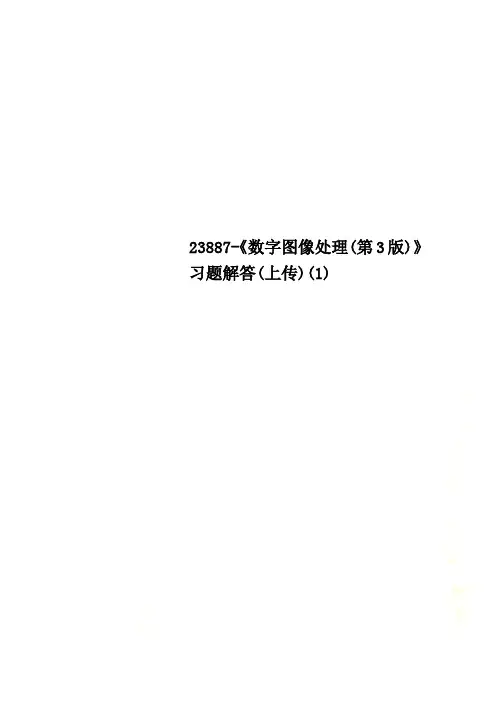
23887-《数字图像处理(第3版)》习题解答(上传)(1)胡学龙编著《数字图像处理(第 3 版)》思考题与习题参考答案目录第1章概述 (1)第2章图像处理基本知识 (4)第3章图像的数字化与显示 (7)第4章图像变换与二维数字滤波 (10)第5章图像编码与压缩 (16)第6章图像增强 (20)第7章图像复原 (25)第8章图像分割 (27)第9章数学形态学及其应用 (31)第10章彩色图像处理 (32)第1章概述1.1连续图像和数字图像如何相互转换?答:数字图像将图像看成是许多大小相同、形状一致的像素组成。
这样,数字图像可以用二维矩阵表示。
将自然界的图像通过光学系统成像并由电子器件或系统转化为模拟图像(连续图像)信号,再由模拟/数字转化器(ADC)得到原始的数字图像信号。
图像的数字化包括离散和量化两个主要步骤。
在空间将连续坐标过程称为离散化,而进一步将图像的幅度值(可能是灰度或色彩)整数化的过程称为量化。
1.2采用数字图像处理有何优点?答:数字图像处理与光学等模拟方式相比具有以下鲜明的特点:1.具有数字信号处理技术共有的特点。
(1)处理精度高。
(2)重现性能好。
(3)灵活性高。
2.数字图像处理后的图像是供人观察和评价的,也可能作为机器视觉的预处理结果。
3.数字图像处理技术适用面宽。
4.数字图像处理技术综合性强。
1.3数字图像处理主要包括哪些研究内容?答:图像处理的任务是将客观世界的景象进行获取并转化为数字图像、进行增强、变换、编码、恢复、重建、编码和压缩、分割等处理,它将一幅图像转化为另一幅具有新的意义的图像。
1.4 说出图像、视频(video)、图形(drawing)及动画(animation)等视觉信息之间的联系和区别。
答:图像是用成像技术形成的静态画面;视频用摄像技术获取动态连续画面,每一帧可以看成是静态的图像。
图形是人工或计算机生成的图案,而动画则是通过把人物的表情、动作、变化等分解后画成许多动作瞬间的画幅,再用摄影机连续拍摄成一系列画面,给视觉造成连续变化的图画。
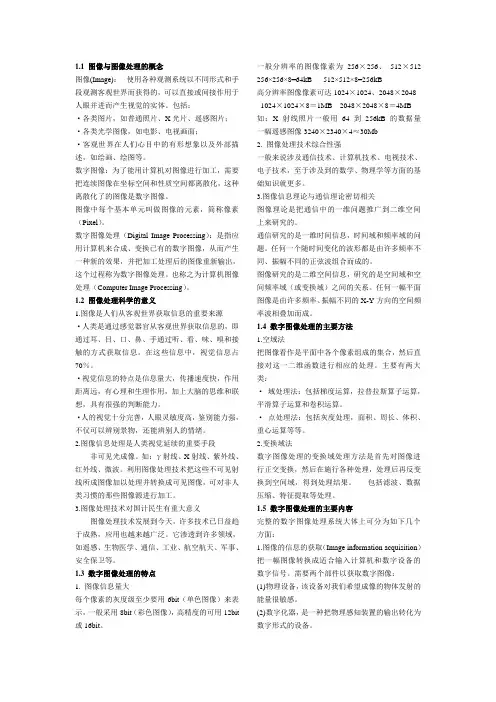
1.1 图像与图像处理的概念图像(Image):使用各种观测系统以不同形式和手段观测客观世界而获得的,可以直接或间接作用于人眼并进而产生视觉的实体。
包括:·各类图片,如普通照片、X光片、遥感图片;·各类光学图像,如电影、电视画面;·客观世界在人们心目中的有形想象以及外部描述,如绘画、绘图等。
数字图像:为了能用计算机对图像进行加工,需要把连续图像在坐标空间和性质空间都离散化,这种离散化了的图像是数字图像。
图像中每个基本单元叫做图像的元素,简称像素(Pixel)。
数字图像处理(Digital Image Processing):是指应用计算机来合成、变换已有的数字图像,从而产生一种新的效果,并把加工处理后的图像重新输出,这个过程称为数字图像处理。
也称之为计算机图像处理(Computer Image Processing)。
1.2 图像处理科学的意义1.图像是人们从客观世界获取信息的重要来源·人类是通过感觉器官从客观世界获取信息的,即通过耳、目、口、鼻、手通过听、看、味、嗅和接触的方式获取信息。
在这些信息中,视觉信息占70%。
·视觉信息的特点是信息量大,传播速度快,作用距离远,有心理和生理作用,加上大脑的思维和联想,具有很强的判断能力。
·人的视觉十分完善,人眼灵敏度高,鉴别能力强,不仅可以辨别景物,还能辨别人的情绪。
2.图像信息处理是人类视觉延续的重要手段非可见光成像。
如:γ射线、X射线、紫外线、红外线、微波。
利用图像处理技术把这些不可见射线所成图像加以处理并转换成可见图像,可对非人类习惯的那些图像源进行加工。
3.图像处理技术对国计民生有重大意义图像处理技术发展到今天,许多技术已日益趋于成熟,应用也越来越广泛。
它渗透到许多领域,如遥感、生物医学、通信、工业、航空航天、军事、安全保卫等。
1.3 数字图像处理的特点1. 图像信息量大每个像素的灰度级至少要用6bit(单色图像)来表示,一般采用8bit(彩色图像),高精度的可用12bit 或16bit。
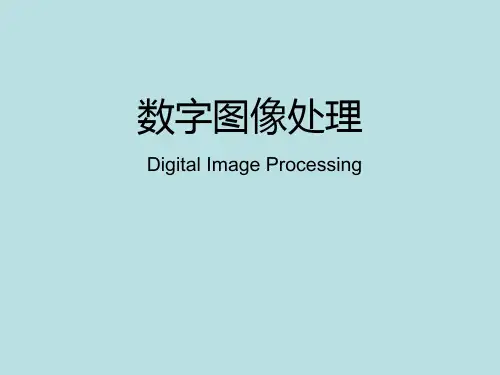
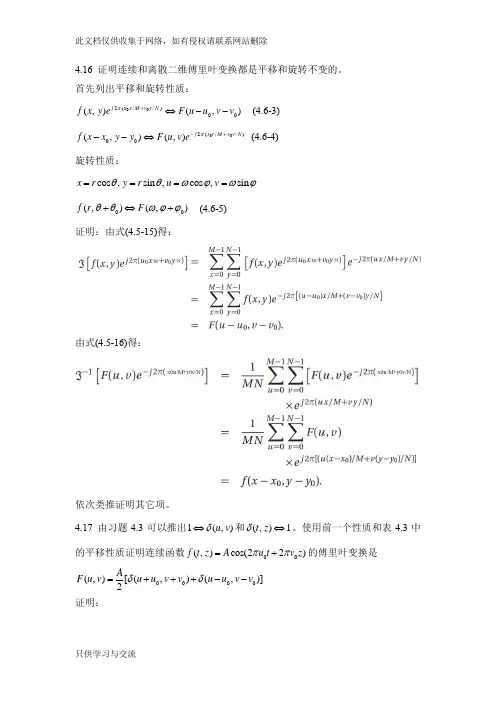
4.16 证明连续和离散二维傅里叶变换都是平移和旋转不变的。
首先列出平移和旋转性质:002(//)00(,)(,)j u x M v y N f x y e F u u v v π+⇔-- (4.6-3) 002(//)00(,)(,)j x r M y v N f x x y y F u v e π-+--⇔ (4.6-4)旋转性质:cos ,sin ,cos ,sin x r y r u v θθωϕωϕ====00(,)(,)f r F θθωϕϕ+⇔+ (4.6-5) 证明:由式(4.5-15)得:由式(4.5-16)得:依次类推证明其它项。
4.17 由习题4.3可以推出1(,)u v δ⇔和(,)1t z δ⇔。
使用前一个性质和表4.3中的平移性质证明连续函数00(,)cos(22)f t z A u t v z ππ=+的傅里叶变换是0000(,)[(,)(,)]2AF u v u u v v u u v v δδ=+++-- 证明:000000002()2()002()2()2()2()2()2()2((,)(,)cos(22)[]222j ut vz j ut vz j u t v z j u t v z j ut vz j u t v z j u t v z j ut vz j u F u v f t z e dtdzA u t v z e dtdzA e e e dtdzA A e e dtdz e e πππππππππππ∞∞-+-∞-∞∞∞-+-∞-∞∞∞+-+-+-∞-∞∞∞+-+-+--∞-∞==+=+=+⎰⎰⎰⎰⎰⎰⎰⎰)00000000(,)(,)22[(,)(,)]2t vz dtdz A Au u v v u u v v Au u v v u u v v δδδδ∞∞+-∞-∞=--+++=--+++⎰⎰ 4.18 证明离散函数(,)1f x y =的DFT 是1,0{1}(,)0,u v u v δ==⎧ℑ==⎨⎩其它证明:离散傅里叶变换112(//)00(,)(,)M N j ux M vy N x y F u v f x y e π---+===∑∑112(//)00112(//)00{1}M N j ux M vy N x y M N j ux M vy N x y e e ππ---+==---+==ℑ==∑∑∑∑如果0u v ==,{1}1ℑ=,否则:1100{1}{cos[2(//)]sin[2(//)]}M N x y ux M vy N j ux M vy N ππ--==ℑ=+-+∑∑考虑实部,1100{1}cos[2(//)]M N x y ux M vy N π--==ℑ=+∑∑,cos[2(//)]ux M vy N π+的值介于[-1, 1],可以想象,1100{1}cos[2(//)]0M N x y ux M vy N π--==ℑ=+=∑∑,虚部相同,所以1,0{1}(,)0,u v u v δ==⎧ℑ==⎨⎩其它4.19 证明离散函数00cos(22)u x v y ππ+的DFT 是00001(,)[(,)(,)]2F u v u Mu v Nv u Mu v Nv δδ=+++--证明:000000112(//)00112(//)0000112()2()2(//)00112()2(//)00(,)(,)cos(22)1[]21{2M N j ux M vy N x y M N j ux M vy N x y M N j u x v y j u x v y j ux M vy N x y M N j u x v y j ux M vy N x y F u v f x y e u x v y e e e e e e πππππππππ---+==---+==--+-+-+==--+-+====+=+=∑∑∑∑∑∑∑∑000000112()2(//)0011112(//)2(//)2(//)2(//)00000000}1{}21[(,)(,)]2M N j u x v y j ux M vy N x y M N M N j Mu x M Nv y N j Mu x M Nv y N j ux M vy N j ux M vy N x y x y e e e e e e u Mu v Nv u Mu v Nv ππππππδδ---+-+==----+-+-+-+====+=+=+++--∑∑∑∑∑∑4.20 下列问题与表4.1中的性质有关。
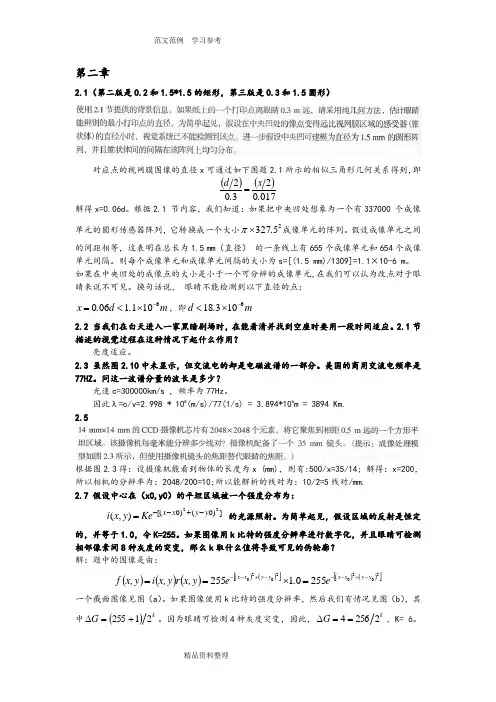
第二章2.1(第二版是0.2和1.5*1.5的矩形,第三版是0.3和1.5圆形)对应点的视网膜图像的直径x 可通过如下图题2.1所示的相似三角形几何关系得到,即()()01702302.x .d =解得x=0.06d 。
根据2.1 节内容,我们知道:如果把中央凹处想象为一个有337000 个成像单元的圆形传感器阵列,它转换成一个大小25327.⨯π成像单元的阵列。
假设成像单元之间的间距相等,这表明在总长为1.5 mm (直径) 的一条线上有655个成像单元和654个成像单元间隔。
则每个成像单元和成像单元间隔的大小为s=[(1.5 mm)/1309]=1.1×10-6 m 。
如果在中央凹处的成像点的大小是小于一个可分辨的成像单元,在我们可以认为改点对于眼睛来说不可见。
换句话说, 眼睛不能检测到以下直径的点:m .d .x 61011060-⨯<=,即m .d 610318-⨯<2.2 当我们在白天进入一家黑暗剧场时,在能看清并找到空座时要用一段时间适应。
2.1节描述的视觉过程在这种情况下起什么作用?亮度适应。
2.3 虽然图2.10中未显示,但交流电的却是电磁波谱的一部分。
美国的商用交流电频率是77HZ 。
问这一波谱分量的波长是多少?光速c=300000km/s ,频率为77Hz 。
因此λ=c/v=2.998 * 108(m/s)/77(1/s) = 3.894*106m = 3894 Km. 2.5根据图2.3得:设摄像机能看到物体的长度为x (mm),则有:500/x=35/14; 解得:x=200,所以相机的分辨率为:2048/200=10;所以能解析的线对为:10/2=5线对/mm. 2.7 假设中心在(x0,y0)的平坦区域被一个强度分布为:])0()0[(22),(y y x x Ke y x i -+--= 的光源照射。
为简单起见,假设区域的反射是恒定的,并等于1.0,令K=255。
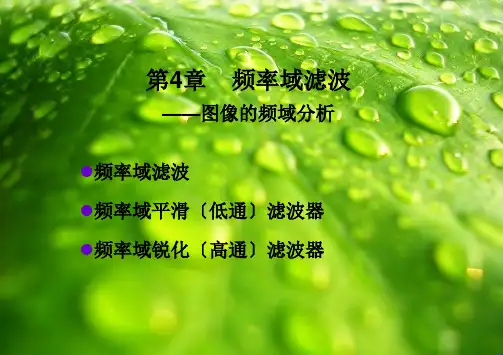
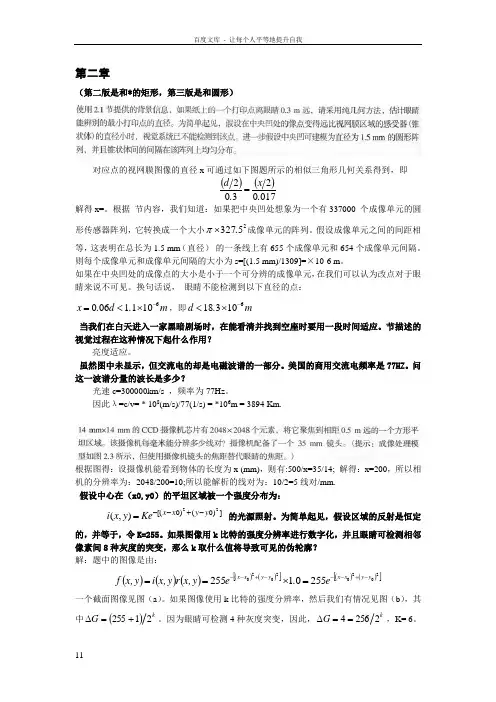
第二章(第二版是和*的矩形,第三版是和圆形)对应点的视网膜图像的直径x 可通过如下图题所示的相似三角形几何关系得到,即()()01702302.x .d =解得x=。
根据 节内容,我们知道:如果把中央凹处想象为一个有337000 个成像单元的圆形传感器阵列,它转换成一个大小25327.⨯π成像单元的阵列。
假设成像单元之间的间距相等,这表明在总长为1.5 mm (直径) 的一条线上有655个成像单元和654个成像单元间隔。
则每个成像单元和成像单元间隔的大小为s=[(1.5 mm)/1309]=×10-6 m 。
如果在中央凹处的成像点的大小是小于一个可分辨的成像单元,在我们可以认为改点对于眼睛来说不可见。
换句话说, 眼睛不能检测到以下直径的点:m .d .x 61011060-⨯<=,即m .d 610318-⨯<当我们在白天进入一家黑暗剧场时,在能看清并找到空座时要用一段时间适应。
节描述的视觉过程在这种情况下起什么作用?亮度适应。
虽然图中未显示,但交流电的却是电磁波谱的一部分。
美国的商用交流电频率是77HZ 。
问这一波谱分量的波长是多少?光速c=300000km/s ,频率为77Hz 。
因此λ=c/v= * 108(m/s)/77(1/s) = *106m = 3894 Km.根据图得:设摄像机能看到物体的长度为x (mm),则有:500/x=35/14; 解得:x=200,所以相机的分辨率为:2048/200=10;所以能解析的线对为:10/2=5线对/mm. 假设中心在(x0,y0)的平坦区域被一个强度分布为:])0()0[(22),(y y x x Ke y x i -+--= 的光源照射。
为简单起见,假设区域的反射是恒定的,并等于,令K=255。
如果图像用k 比特的强度分辨率进行数字化,并且眼睛可检测相邻像素间8种灰度的突变,那么k 取什么值将导致可见的伪轮廓? 解:题中的图像是由:()()()()()[]()()[]20202020********y y x x y y x x e .e y ,x r y ,x i y ,x f -+---+--=⨯==一个截面图像见图(a )。
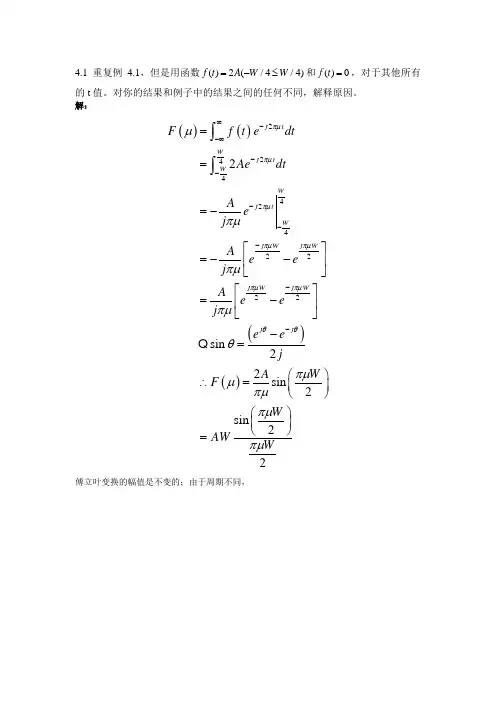
4.1 重复例4.1,但是用函数()2(/4/4)f t A W W =-≤和()0f t =,对于其他所有的t 值。
对你的结果和例子中的结果之间的任何不同,解释原因。
解:()()()()224442422222sin 22sin 2sin 22j tWj tW Wj tW j Wj W j W j Wj j F f t e dtA edtA ej A ee j A e ej ee jAW F W A WWπμπμπμπμπμπμπμθθμπμπμπμθπμμπμπμπμ∞--∞-------===-⎡⎤=--⎢⎥⎣⎦⎡⎤=-⎢⎥⎣⎦-=⎛⎫∴=⎪⎝⎭⎛⎫ ⎪⎝⎭=⎰⎰傅立叶变换的幅值是不变的;由于周期不同,4.2 证明式(4.4-2)()()()()()()~~2222j tj tn j tn j n Ttn n F f t edtf t t n T edt f t t n T edt f eπμπμπμπμμδδ∞--∞∞∞--∞=-∞∞∞--∞=-∞∞-∆=-∞==-∆=-∆=⎰∑⎰∑⎰∑中的()~F μ在两个方向上是无限周期的,周期为1/T ∆证明:(1) 要证明两个方向上是无限周期1/T ∆,只需证明根据如下式子:可得:其中上式第三行,由于k, n 是整数,且和的极限是关于原点对称。
(2) 同样的需要证明根据如下式子:()()()()()()~~2222j tj tn j tn j n Ttn n F f t edtf t t n T edt f t t n T edt f eπμπμπμπμμδδ∞--∞∞∞--∞=-∞∞∞--∞=-∞∞-∆=-∞==-∆=-∆=⎰∑⎰∑⎰∑可得:其中第三行由于k, n 都为整数,所以21j kneπ-=。
4.3 可以证明(Brancewell[2000])1()1()t t δδ⇔⇔和。
使用前一个性质和表4.3中的平移性质,证明连续函数()cos(2)f t nt π=的傅立叶变换是()()()()1/2F n n μδμδμ=++-⎡⎤⎣⎦,其中是一个实数。

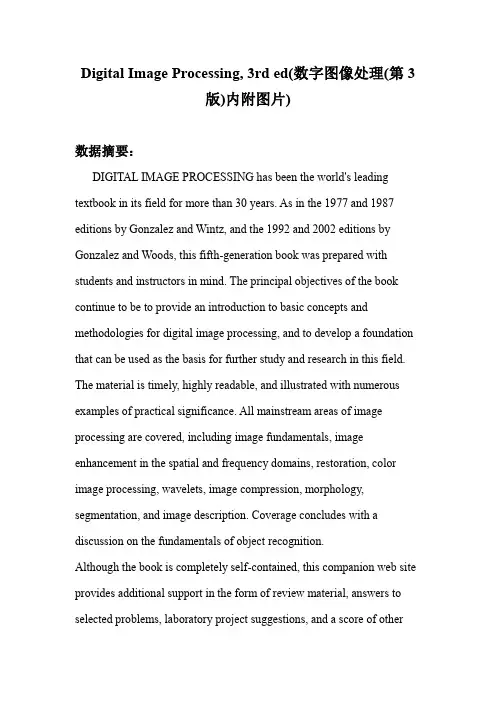
Digital Image Processing, 3rd ed(数字图像处理(第3版)内附图片)数据摘要:DIGITAL IMAGE PROCESSING has been the world's leading textbook in its field for more than 30 years. As in the 1977 and 1987 editions by Gonzalez and Wintz, and the 1992 and 2002 editions by Gonzalez and Woods, this fifth-generation book was prepared with students and instructors in mind. The principal objectives of the book continue to be to provide an introduction to basic concepts and methodologies for digital image processing, and to develop a foundation that can be used as the basis for further study and research in this field. The material is timely, highly readable, and illustrated with numerous examples of practical significance. All mainstream areas of image processing are covered, including image fundamentals, image enhancement in the spatial and frequency domains, restoration, color image processing, wavelets, image compression, morphology, segmentation, and image description. Coverage concludes with a discussion on the fundamentals of object recognition.Although the book is completely self-contained, this companion web site provides additional support in the form of review material, answers to selected problems, laboratory project suggestions, and a score of otherfeatures. A supplementary instructor's manual is available to instructors who have adopted the book for classroom use. See also a partial list of institutions that use the book.One of the principal reasons this book has been the world leader in its field for more than 30 years is the level of attention we pay to the changing educational needs of our readers. The present edition is based on the most extensive survey we have ever conducted. The survey involved faculty, students, and independent readers of the book in 134 institutions from 32 countries. Many of the following new features are based on the results of that survey.中文关键词:数字图像处理,图像基础,图像在空间和频率域的增强,图像压缩,图像描述,英文关键词:digital image processing,image fundamentals,image compression,image description,数据格式:IMAGE数据用途:数字图像处理数据详细介绍:Digital Image Processing, 3rd editionBasic Information:ISBN number 9780131687288.Publisher: Prentice Hall12 chapters.954 pages.© 2008.DIGITAL IMAGE PROCESSING has been the world's leading textbook in its field for more than 30 years. As in the 1977 and 1987 editions by Gonzalez and Wintz, and the 1992 and 2002 editions by Gonzalez and Woods, this fifth-generation book was prepared with students and instructors in mind. The principal objectives of the book continue to be to provide an introduction to basic concepts and methodologies for digital image processing, and to develop a foundation that can be used as the basis for further study and research in this field. The material is timely, highly readable, and illustrated with numerous examples of practical significance. All mainstream areas of image processing are covered, including image fundamentals, imageenhancement in the spatial and frequency domains, restoration, color image processing, wavelets, image compression, morphology, segmentation, and image description. Coverage concludes with a discussion on the fundamentals of object recognition.Although the book is completely self-contained, this companion web site provides additional support in the form of review material, answers to selected problems, laboratory project suggestions, and a score of other features. A supplementary instructor's manual is available to instructors who have adopted the book for classroom use. See also a partial list of institutions that use the book.One of the principal reasons this book has been the world leader in its field for more than 30 years is the level of attention we pay to the changing educational needs of our readers. The present edition is based on the most extensive survey we have ever conducted. The survey involved faculty, students, and independent readers of the book in 134 institutions from 32 countries. Many of the following new features are based on the results of that survey.NEW FEATURESA revision of introductory concepts that provides readers with foundation material much earlier in the book than before.A revised and updated discussion of intensity transformation, spatialcorrelation, convolution, and their application to spatial filtering.New discussion of fuzzy sets and their application to image processing.A new chapter on the discrete Fourier transform and frequency domain processing.New coverage of computerized tomography.A revision of the wavelets chapter.A new chapter on data compression, including new compression techniques, digital video compression, standards, and watermarking.New coverage of morphological reconstruction, gray-scale morphology, and advanced morphological algorithms.New coverage of the Marr-Hildreth and Canny edge detection algorithms.Expanded coverage of image thresholding.New examples and illustrations involving over 400 new images and more than 200 new drawings and tables.Expanded homework sets, including over 80 new problems.Updated bibliography.Differences Between the DIP and DIPUM BooksDigital Image Processing is a book on fundamentals.Digital Image Processing Using MATLAB is a book on the software implementation of those fundamentals.The key difference between the books is that Digital Image Processing (DIP) deals primarily with the theoretical foundation of digital image processing, while Digital Image Processing Using MATLAB (DIPUM) is a book whose main focus is the use of MATLAB for image processing. The DIPUM book covers essentially the same topics as DIP, but the theoretical treatment is not as detailed. Some instructors prefer to fill in the theoretical details in class in favor of having available a book with a strong emphasis on implementation.© 2008 by Pearson Education, Inc.Pearson Prentice HallPearson Education, Inc.Upper Saddle River, New Jersey 07458All rights reserved. No part of this book may be reproduced, in any form, or by any means, without permission in writing from the publisher. Pearson Prentice Hall ® is a trademark of Pearson Education, Inc. The authors and publisher of this book have used their best efforts in preparing this book.These efforts include the development, research, and testing of the theories and programs to determine their effectiveness.The authors and publisher make no warranty of any kind, expressed or implied,with regard to these programs or the documentation contained in this book.The authors and publisher shall not be liable in any event for incidental or consequential damages with, or arising outof, the furnishing, performance, or use of these programs. 数据预览:点此下载完整数据集。
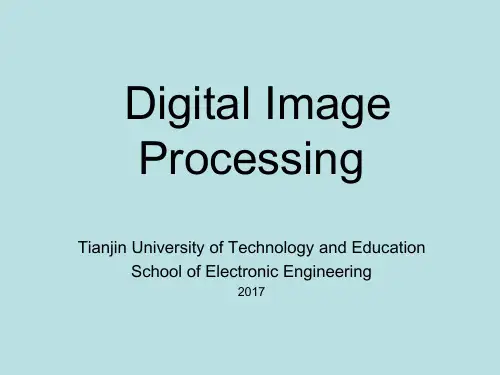
数字图像处理第三版中文答案解析引言《数字图像处理》是一本经典的图像处理教材,目前已经出版了第三版。
本文是对该书答案解析的总结,将分析和解释书中的问题和答案。
目录•第一章:绪论•第二章:数字图像基础•第三章:灰度变换•第四章:空间滤波•第五章:频域滤波•第六章:图像复原•第七章:几何校正•第八章:彩色图像处理•第九章:小波与多分辨率处理第一章:绪论本章主要介绍了数字图像处理的概念和基本步骤。
答案解析中包括对一些基本概念和术语的解释,以及相关的数学公式和图像处理方法的应用。
第二章:数字图像基础本章介绍了数字图像的表示和存储方法,以及图像的采样和量化过程。
答案解析中详细解释了图像的像素值和灰度级之间的关系,以及采样频率和量化步长对图像质量的影响。
第三章:灰度变换本章讲述了图像的灰度变换方法,包括线性和非线性变换。
答案解析中对不同灰度变换函数的作用和效果进行了解释,并给出了一些实例和应用。
第四章:空间滤波本章介绍了图像的空间滤波方法,包括平滑和锐化滤波。
答案解析中解释了不同滤波器的原理和效果,并给出了滤波器设计的步骤和实例。
第五章:频域滤波本章讲述了图像的频域滤波方法,包括傅里叶变换和滤波器设计。
答案解析中详细解释了傅里叶变换的原理和应用,以及频域滤波器的设计方法和实例。
第六章:图像复原本章介绍了图像的复原方法,包括退化模型和复原滤波。
答案解析中详细解释了退化模型的建立和复原滤波器的设计方法,以及如何根据退化模型进行图像复原的实例。
第七章:几何校正本章讲述了图像的几何校正方法,包括图像的旋转、缩放和平移等操作。
答案解析中给出了不同几何变换的矩阵表示和变换规则,以及几何校正的应用实例。
第八章:彩色图像处理本章介绍了彩色图像的表示和处理方法,包括RGB和HSV 等颜色模型的转换和处理。
答案解析中详细解释了不同颜色模型的表示和转换方法,以及彩色图像处理的实例和应用。
第九章:小波与多分辨率处理本章讲述了小波和多分辨率处理的方法和应用。
Corrections and Clarifications Digital Image Processing3rd EditionGonzalez and WoodsPrentice Hall© 2008December 5, 2013CORRECTIONS05 December, 2013The bottom, leftmost pixel in the Marker Image, F, should be white.The caption in Fig. 9.32(a) should read: Reconstruction-by-dilation of marker image.05 December, 201305 December, 2013CLARIFICATIONSPageClarifications59, last sentence, 2ndparagraph. It is assumed also that the physical dimensions of the chips are the same.117, 2nd paragraph of Ex 3.3.Figure 3.12(c) was generated with a transformation function of the form shown in Fig. 3.11(b), but with the value of the constant part of the curve set to 0 instead of the high value shown in Fig. 3.11(b) .661, Fig. 9.31(c). Although the image appears as a uniform black rectangle (all 0s), there are 1-valued points along its boundary that are difficult to see at the image scale shown and also because the background (page) iswhite (i.e., 1-valued). See the 3rd sentence in the first paragraph of page 661.694, Fig. 10.2(a). The image in Fig. 10.2(a) should have the dot shown.In some printings of the book the dot is barely visible, while in others it shows perfectly, as in the image shown on the right. Also, small, random printing imperfections that sometimes show in white or gray can be confusing, and should beignored. [Note: If you'reusing a low resolution monitor you may need to magnify this document in order to see the dot.]697, Fig. 10.4(d) The image in Fig. 10.4(d) should have the single dotshown. The image is black (0) elsewhere. In some printings of the book the dot is barely visible, while in others it shows perfectly, as in the image shown on the right. Also, small, random printing imperfections that sometimes show in white or gray can be confusing, and should be ignored. The correct image consists of a single white dot on a uniform black background.872, Fig. 12.9(d). The image in Fig. 10.9(d) should have the single whitedot shown. The image is black (0) elsewhere. In some printings of the book the dot is barely visible, while in others it shows perfectly, as in the image shown on the right. Also, small random printing imperfections that sometimes show in white or gray can be confusing, and should be ignored. The correct imageconsists of a single white dot on a uniform black background.05 December, 2013Pg 655, Fig, 9.25 Edit figure to look like the one on the right.773, Fig. 10.55.Note that the pixel identified by the arrow in the top left of the figure is missing in the figure in the book.。